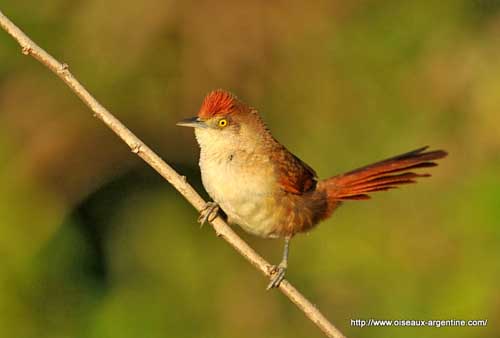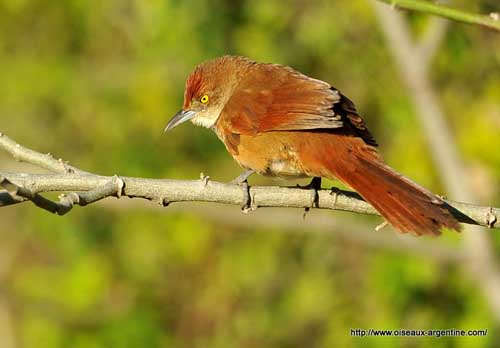
Fr: Synallaxe rouge
All : Rotbrauner Bündelnister
Esp : Espinero Grande
Ital: Espinero maggiore
Nd: Grote Stekelkruin
Sd: Större törnfågel
Port: Graveteiro
Photographers:
Philippe et Aline Wolfer
GALERIE
Text by Nicole Bouglouan
Sources:
HANDBOOK OF THE BIRDS OF THE WORLD Vol 8 By Josep del Hoyo-Andrew Elliott-David Christie - Lynx Edicions - ISBN: 8487334504
BirdLife International (BirdLife International)
Greater Thornbird
Phacellodomus ruber
Passeriforme Order – Furnariidae Family
BIOMETRICS:
Length: 19-21 cm
Weight: 35-50 g
DESCRIPTION:
The Greater Thornbird is one of the largest and bulkiest thornbirds of genus Phacellodomus. Its reddish plumage is probably the brightest too.
On the upperparts, the adult has reddish-chestnut crown with pale fine streaks and stiffened feathers. Nape and back are reddish-brown to olive-brown, but there are numerous individual variations. Lower back and uppertail-coverts are chestnut, but the rump is pale rufous-brown. The graduated tail is reddish-chestnut. The wings are mostly rufous-chestnut.
On the underparts, chin and throat are whitish, whereas the breast is slightly washed brownish, darker at side. The belly is whitish, but flanks and undertail-coverts are light rufous-brown.
On the head, the face is rufescent-brown to greyish-brown, with paler lores and supercilium.
The two-tone bill has blackish upper mandible and pale grey lower mandible. It is fairly thick and slightly decurved. The eyes are pale yellow, orange-yellow or orange. Legs and feet are grey.

Male and female are similar.
The juvenile has indistinct crown patch and mottled brownish breast.
VOICE: SOUNDS BY XENO-CANTO
The Greater Thornbird’s call is a sharp “check-check”. The song starts with burst of notes followed by progressive accelerating notes and fading towards the end. It is a long series of 15-20 “chip” notes.
The members of a pair also perform duets, often used as aggressive response to disturbance or intruders.
HABITAT:
The Greater Thornbird often occurs near water in thickets, woodlands and scrublands, near ponds and occasionally in emergent marshy vegetation for foraging.
This species is visible between 300 and 1100 metres of elevation, and locally higher, up to 1400 metres in Bolivia.
RANGE:
The Greater Thornbird is resident in its range in Bolivia, interior S Brazil, Paraguay and N Argentina.
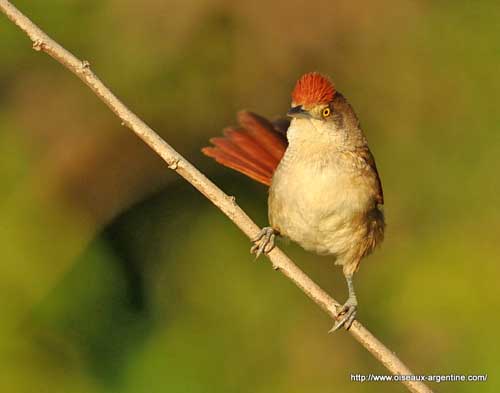
BEHAVIOUR:
The Greater Thornbird feeds on insects and other invertebrates. This species is often terrestrial and forages alone or in pairs on the forest floor, but also in the understorey where it gleans invertebrates from the dense vegetation and near the borders of marshes.
These retiring birds move cautiously into the vegetation, and are usually detected thanks to their explosive song.
During the breeding season, the stiffened crown feathers are probably enhanced and erect, as the graduated tail which is cocked and fanned. But the breeding behaviour is poorly known.
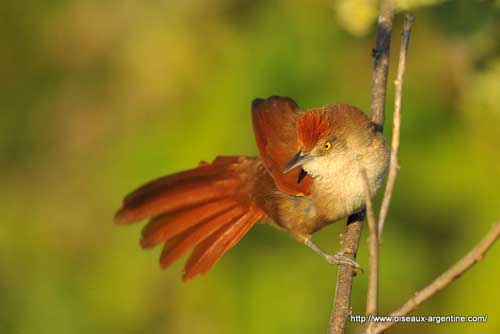
They are territorial all year round, and could remain within a fairly small territory. The pair-bonds persist outside the breeding season and last probably for life.
FLIGHT:
The Greater Thornbird, as most Furnariidae species has relatively short and rounded wings reflecting the sedentary status and the absence of aerial foraging. They only fly between several foraging sites.
REPRODUCTION:
The breeding season occurs during the austral spring-summer;
The Greater Thornbird builds a bulky, cone-shaped structure made with twigs and sticks, often thorny ones. There is a side entrance at lower level, leading to the nest-chamber, and occasionally to an antechamber. The nest-chamber of 10-12 cm in diameter is lined with soft materials such as fine grasses and feathers.
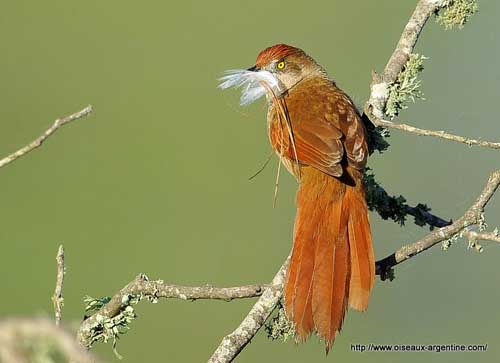
Such nest may reach 35-60 cm tall, with a diameter of 30-50 cm at base. Some sticks are as long as 50-60 cm.
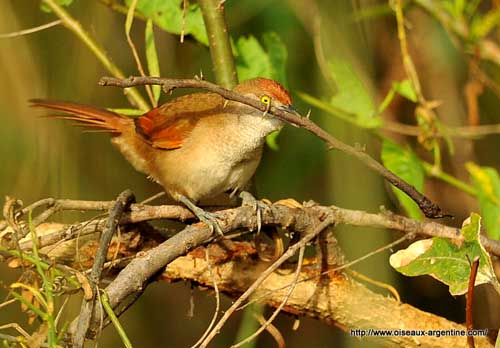
This structure is suspended between 1, 50 and 3 metres above the low vegetation, and often over water. It may occasionally be placed at top of an old nest.
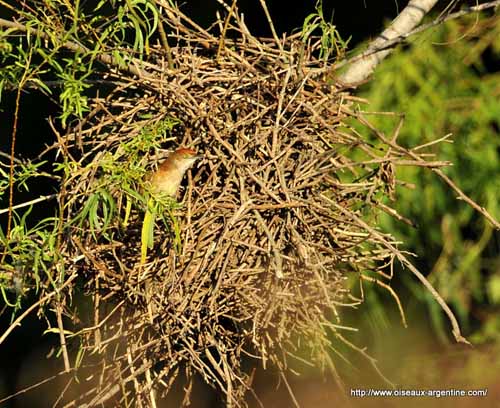
The female lays 3-4 white eggs between October and January.
There is no more information about the nesting habits, but the incubation period lasts about 20-22 days as in the largest Furnariidae species, and is shared by both parents which also feed the young together.
In Furnariidae, the nestling period ranges from 13 to 29 days for the largest species, and can suggest that the young Greater Thornbirds fledge about 25-29 days after hatching.
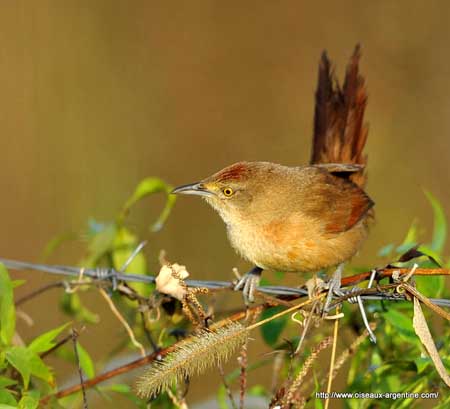
DIET:
The Greater Thornbird forages mainly on the ground and gleans arthropods from the vegetation. It feeds on insects such as ants and Coleopterans, and other invertebrates.
PROTECTION / THREATS / STATUS:
The Greater Thornbird occurs in several protected areas, and appears uncommon to locally common throughout its range.
This species is not currently threatened.
